StarCraft II: Heart of the Swarm – Singleplayer Review
by Ste
|
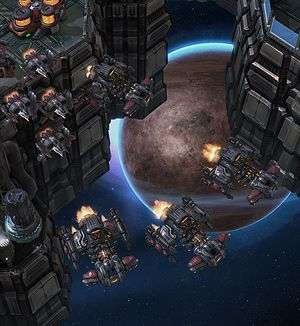 Heart of the Swarm is the first of two planned expansions to Blizzard’s hit StarCraft II: Wings of Liberty (WoL) and came approximately two years after the main game’s release. For the uninitiated, StarCraft II is a traditional-style RTS game set in a corner of the galaxy known as the Koprulu Sector. Players control one of three races – Terrans, Protoss or Zerg – and must collect resources in order for them to build a base, raise an army and then kick a few shades of shit out of their enemies.
Heart of the Swarm is the first of two planned expansions to Blizzard’s hit StarCraft II: Wings of Liberty (WoL) and came approximately two years after the main game’s release. For the uninitiated, StarCraft II is a traditional-style RTS game set in a corner of the galaxy known as the Koprulu Sector. Players control one of three races – Terrans, Protoss or Zerg – and must collect resources in order for them to build a base, raise an army and then kick a few shades of shit out of their enemies.
Like most games in this genre, Heart of the Swarm (HotS) comes in two flavours: single-player and multiplayer. What usually happens when playing this type of game is that you’d find that the multiplayer is simply an afterthought to the main single-player campaign, and occasionally it will be the other way around with the single-player being nothing more than a tutorial for the multiplayer element. However, this isn’t the case with HotS, as the two modes play so differently that a separate multiplayer review is warranted in order to cover both modes satisfactorily.
Unlike the WoL campaign, which saw you take control of Jim Raynor and his Terran rebels – Raynor’s Raiders – in an effort to stop the Zerg, the HotS campaign is all about Sarah Kerrigan and her Zerg minions. If you weren’t aware, the Zerg were created as bio weapons by a long-extinct race, the Xel’Naga, thousands of years ago. However, they became uncontrollable and eventually escaped to cause havoc. Kerrigan, formally a Terran, was captured by the Zerg Overmind in the original StarCraft game because of her powerful Psionic abilities. She was subsequently transformed into the Queen of Blades who then went on to destroy the Overmind and eventually take control of the Zerg Swarm herself.
When HotS starts, it’s been a short time after the events of the WoL campaign. Sarah Kerrigan has been captured and turned part-human again by the rebel Jim Raynor, who used the power of an ancient Xel’Naga device at the end of WoL. After a brief but incredibly polished cut scene, the game begins with a basic tutorial mission where you take on the role of Kerrigan, who is in lock-down in a secret rebel base. It turns out that Kerrigan can still control a small number of Zerg units and, under the guise of trying to see how strong her remaining powers are, the mission takes you through the basics of movement, building units/structures, and attacking. It’s a solid introduction to the controls for new or returning players and, at the same time, does a good job not to condescend to the more experienced players.
At the end of the tutorial you are liberated from your Terran gaolers and left to your own devices, which is when the story starts in earnest, if you can call it much of a story. The plot is a massively cheesy tale of love and revenge, with Kerrigan at the heart of it all going on a merry rampage across the sector, and by ‘sector’ I mean a handful of planets. The HotS campaign seems to take itself a little more seriously that WoL did, with Kerrigan often struggling to keep hold of her humanity while the Zerg in her begins to regain its hold. I felt that the plot was trying too hard, and on more than one occasion I was wishing for the space cowboys from the last game, so if you are into serious and gripping story-telling, you won’t find it here.
However, just because it’s cheesy and tries to take itself too seriously, it doesn’t mean that it’s a big pile of crap, and I’m sure that, providing you can get over the nonsense, you will still get something out of the story. In contrast, the voice acting and the cut scenes tying all the cheese together are actually beautiful. I’ve not seen cut scenes of this quality since, well, WoL.
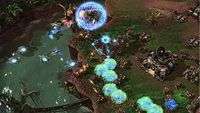 |
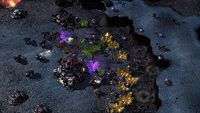 |
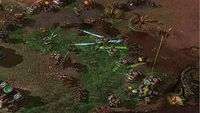 |
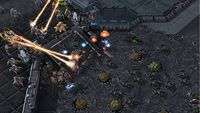 |
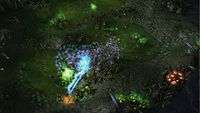 |
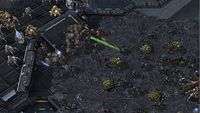 |
All is not lost though, and, as you’d expect, the game does share similarities with WoL. The time between missions is spent on a giant, space-faring Zerg Leviathan which acts much like the Hyperion did in the last game, although the Leviathan seems stripped down when compared to the Hyperion. The bridge (gob?) of the Leviathan acts as a jump-off point for the four other areas. If you want to go to the Evolution chamber, for example, you simply click on the button to take you there, but in order to go anywhere else you must first head back to the bridge before selecting another area. It would be a minor gripe if the limited number of areas were anywhere near as interactive as those on the Hyperion. Instead of the interesting characters such as Tychus Findlay and Matt Horner, and all the interactive things in the background, the Leviathan is populated with their miserable Zerg counterparts which, despite coming in some weird and wonderful shapes and sizes, are really quite dull. The only one character that I found to be remotely interesting was Abathur, who helps Kerrigan mutate and upgrade her Zerg units. In the end, though, you don’t really find out that much about him other than he has a vagina for a face, which may have been the reason I was drawn to him in the first place. That interesting and rather disturbing fact aside, I think Blizzard really missed a trick not adding more detail to the ship segments.
There are twenty-seven missions in total, seven of which are Evolution based and not really story related but act as a mechanism to upgrade your units, while the twenty story missions span a number of planets and story arcs. Each planet is different in terms of art style and the types of enemies/creatures that you meet. Thankfully, no two missions feel exactly the same; rather than have constant base-building missions, Blizzard mixes things up with a surprising amount of objectives and features which keep the gameplay fresh and fun. The early missions, for example, take place on an ice planet where periodic ice storms freeze your units in place until you can evolve a resistance to cold. It’s not exactly mind-blowing, but it adds an interesting twist to the gameplay. There’s nothing worse than doing the same thing over and over again, but HotS manages not to fall into this classic RTS trap. One particular mission sees you taking control of the Terrans, but it’s not what you’d expect and, rather than spoiling it for you, all I can say is that it’s a lot of fun.
Most of the missions have you controlling Kerrigan and, as you begin to progress through the campaign, her powers start to develop and new skills are gradually unlocked via an XP system. Completing main and bonus objectives during missions earns XP which, once back on the Leviathan, are used to unlock new abilities and passive powers to play with. There are several tiers to unlock, with each having three powers, and you can select one from each tier to be active at any given time. The options come in all shapes and sizes, such as powerful single-target attacks, passive bonuses, and even base improvements such as auto-harvesting gas extractors. These can be swapped around between missions allowing for experimentation, if you’re into that sort of thing, but I found myself picking the most useful powers and sticking with those. The powers themselves, especially the attack-based, are grossly overpowered and give the AI no chance. When in control of Kerrigan, you really do feel like a total fucking badass. In my playthrough on normal, Kerrigan only died once due to a momentary lapse in concentration. Even then it only took a sixty-second wait before she had respawned back at my main base, and she was on her way again.
The interesting thing about the Zerg is that they have the ability to consume other species in order to create new types of units for themselves. This is how new units are unlocked and also what the Evolution missions are all about. In the seven Evolution missions, Abathur, your fanny-faced friend, tasks you with a simple mission which enables you to test out a new strain of an existing unit. These short missions aren’t really missions at all, and are nothing more than an interesting way to choose one of two different single-player-only upgrades for your units. For example, one such mission gives you the option of upgrading your Zerglings to either Raptors or Swarmlings.
Raptors give your Zerglings the ability to jump up to, and down from, higher ground, giving a tactical advantage when trying to avoid an enemy bottleneck or fortified ramp. A Raptor Zergling is also more aggressive and does slightly more damage that a regular Zergling. On the other hand, you could choose the Swarmling variant which gives you the ability to hatch three Swarmlings from an egg instead of the usual two Zergling. Swarmlings also hatch extremely quickly so, once you have the ability to create them, you can overrun your foes or build units to defend your base very quickly. The choice is permanent and can’t be altered on that playthrough, but you’ll never come across a situation later in the game where you need one variant over another in order to complete a mission; the choices are there to simply offer a slightly different style of play.
The Evolution missions are a bit of a double-edged sword in that I think they work very well when compared to the WoL game, which simply gave you two options and showed you a video. The campaign, on the other hand, is slightly cheapened by them as I would have much preferred additional propermissions.
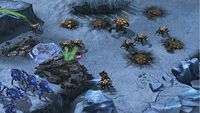 |
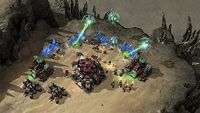 |
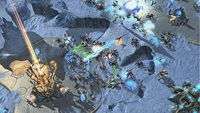 |
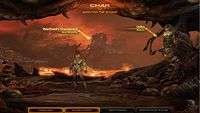 |
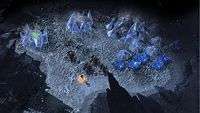 |
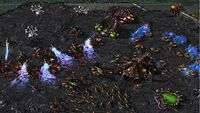 |
Graphically, HotS looks good. Even though it uses a two-and-a-half-year-old engine, I never thought the graphics looked dated at all. It’s not exactly the same as WoL, of course; there have been some minor improvements and tweaks, most noticeably with the physics. Bodies will now skid down ramps and fall off cliffs after dying, which inevitably leads to the odd hilarious moment where you’ll see a dead body go flying across the screen. A few animations also seem to have changed but, overall, it’s still the same game as WoL under that hood. Same goes for the audio; while there are a few new tracks here and there, most people won’t notice too much of a difference from WoL.
In terms of level design, Blizzard are old hats at this. Each level is lovingly crafted, with most having some sort of feature or structure which acts as the lynchpin for the level. One of my favourites was a mission on the jungle planet where you are told to defend your base in the middle of a swamp from waves of attackers. The swamp just happens to be home to lots of little insects which you’re able to mutate and make use of during the level. Every few minutes the swamp will release dozens of insects, on your command, which will attack the foes around you for a limited period of time. Each level also has a number of achievements attached to them, such as don’t take damage from this boss, or do this level in X minutes etc. Most aren’t particularly challenging at the normal difficulty level but they add a certain level of replayability to the proceedings.
As a side note to this, I did experience the odd achievement not popping for me. I had definitely earned them, as they were simply achievements for completing the mission, but they didn’t pop. Even completing the mission a second time didn’t help matters. It may have been due to the always-on requirement of the game, coupled with my dodgy internet connection but, in saying that, at no point did it warn me that I had lost connection to Battle.net so I’m not so sure. It’s a minor gripe, but one which has the potential to piss off completionists.
An expansion wouldn’t be an expansion if it didn’t have a few new units to add to the mix. If you don’t include the single-player-only variations of existing units or the new multiplayer units for the other races, then the single-player element of HotS is a bit of a let down on this front. There are only two new Zerg units added to the game: the Viper and the Swarm Host. The former is a flying spell-caster unit while the latter is a siege-type unit that attacks by producing powerful locusts with a timed lifespan. Both are acceptable, but somehow feel as though they have been added for the sake of adding something new and, as such, I never made much use of either unit.
Additionally, despite what you may have heard about the multiplayer game and its heavy-duty skill requirements, none of this matters in the single-player campaign until you start playing on the “Brutal” difficulty setting. You can quite easily get away with using just your mouse to control your armies, and at no point does the game try to force you to start learning shortcuts and hotkeys. I am by no means an Ace player, however I was quite comfortable tootling along with my mouse on the Hard difficulty without being swarmed for not being quick enough. Quite often I made mistakes but, even so, I wasn’t brutally punished like I would have been if I were playing multiplayer. The HotS campaign is all about enjoyment while still offering a challenge to the more hardcore players if they want it.
I had a good time with the HotS campaign. There are a number of things that it does better than the main game, but there are also some things that are worse, which was a great shame. Most of the bad points can’t be blamed on the fact that it’s “only an expansion” either. Blizzard are better than that, and they should have done better on these points in HotS. Fans of the genre will still go absolutely bat-shit crazy for the game and I think that every RTS fan in the land should buy it as it’s a must in the world of real-time strategy for its gameplay alone, but the story is average at best, with only fancy cut scenes and excellent voice acting saving its Zerg bacon somewhat. The real joy for me was in the missions; the huge variety of objectives and the feeling of being a total badass when in control of Kerrigan. The damage you could do with her more than makes up for the disappointing story, the poor ship areas, and the lacklustre effort put into your shipmates’ backstories.
Pros- Fantastic levels and gameplay features.
- Kerrigan is a wonderfully-powerful character.
- Not a fast-paced shit-storm where mistakes are punishable by defeat.
- Graphics still look great.
- Beautiful-looking cut scenes and great voice acting.
- One of the characters has a vagina for a face.
- Not quite enough levels for my liking.
- Ship-based segments between missions could have been better.
- Only two new Zerg units to play with.
StarCraft II: Heart of the Swarm is by far the best game currently available when it comes to traditional-style RTS games. Despite the story being pants, the gameplay is fantastic. You couldn’t wish for more varied and interesting missions, with my only gripe being that the Evolution missions seemed superfluous and I’m sure many would agree that a few more proper missions would have been the best way to go.
Last five articles by Ste
- Acoustic Gaming: X-Wing Miniatures Game - Review
- Acoustic Gaming: Pandemic Legacy – Season One
- Bored Gaming
- U Wot Mate?
- Tabletop Simulator - Review


















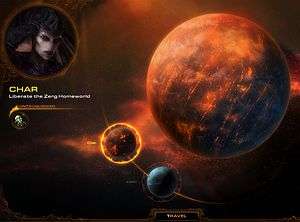
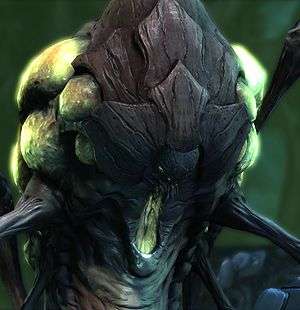
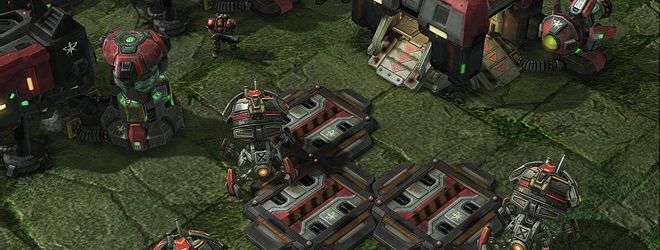
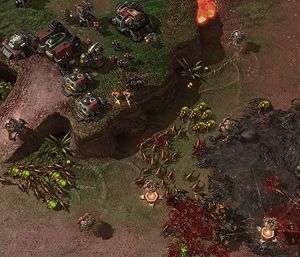
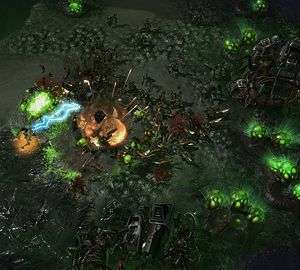
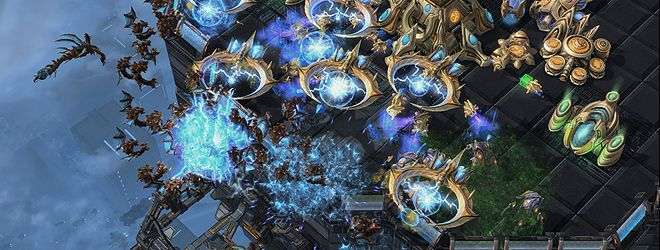
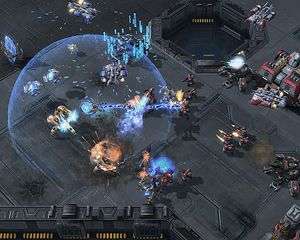






There are no comments, yet.
Why don’t you be the first? Come on, you know you want to!